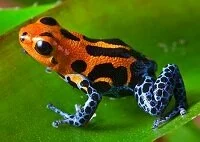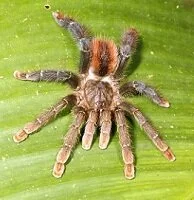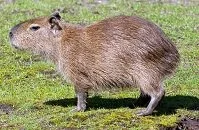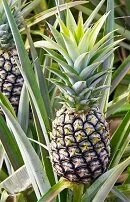Wildlife

Poison dart frog
Few places in the world can compare to Brazil when it comes to wildlife. The country is home to thousands of animals found nowhere else in the world and there are likely hundreds of animals in the country's dense jungles that people don't even know about. Additionally, the plant life in the dense Amazon River basin is incredibly diverse as these plants boast medicinal properties, great beauty, and mystery as nearly one quarter of all of the world's plant species can be found in the Amazon basin.
Of the thousands of animals, the mammal life might be one of the less interesting as the country boasts few indigenous mammals; however the species present are incredible diverse. The jungles are home to jaguars, cougars (puma), monkeys including the howler money and spider monkey, ocelots, tamarins, marmosets, sloths, tapirs, opossums, bats, and thousands of rodents. Elsewhere, and sometimes also in the jungles, there are deer, wolves, boars, anteaters, armadillos, emus, foxes, rabbits, squirrels, mice, rats, and numerous additional rodents, including chinchillas and capybaras.

Tarantula
The sea life is more diverse and perhaps more interesting from the perspective that many of the animals are quite unique. Of course this begins with the mammals as the Amazon manatee and freshwater dolphins both call the country home. The fish and shell fish just expand this variety as some of these animals are common in other parts of the world while others are unique. The pirarucu (arapaima) is one of the world's largest freshwater fishes as it can reach lengths of nearly 10 feet (3 meters). The piranha is also famous and lives in the Amazon, as do the catfish, pike, angelfish, and tetra.
Brazil's sea life continues off its shores with saltwater fish. Dolphins, whales, sea lions, groupers, barracuda, marlin, snapper, mackerel, sharks, shrimp, crab, rays, eels, seahorses, starfish, sea urchins, and jellyfish are all common. There is also a very limited amount of coral reefs off Brazil's shores and here there are also surgeonfish, butterfly fish, and other more brightly colored tropical fish.

Capybara
Birds also call the huge country home as these animals range from tropical rainforest birds to sea birds and everything in between. In the rain forests toucans, macaws, hummingbirds, parakeets, parrots, ducks, condors, and eagles are all common. Some of these birds also live in the woodlands, which are also home to sparrows, cardinals, woodpeckers, partridges, and owls. Then those water loving birds, many of whom also live in the Amazon, include egrets, pelicans, frigate birds, pigeons, and more.
The Amazon rainforests are also home to thousands of reptiles and amphibians, boasting over 1,000 species of frogs alone. Perhaps the most famous of these frogs is the brightly colored poison dart frog. These forests are also home to lizards, iguanas, and snakes, including the famous anaconda and boa constrictor. In the waters of the Amazon River it is not difficult to find turtles, alligators, and other reptiles and amphibians.
It is no surprise that the insects and other small animals living in Brazil are numerous. Beetles, butterflies, mosquitoes, moths, flies, spiders, including the black widow and tarantula, and of course ants call the country home.

Pineapple
When it comes to native plant life, South America is home to many famous edible plants and these plants quickly spread throughout Brazil, South America, and beyond. The pineapple is from the region where Brazil and Uruguay meet while potatoes and tobacco originated in the Andes Mountains. A few others, including cacao trees (used to make chocolate), peanuts, and tomatoes are also from South America, although their actual origin is unknown. One variety of nut, the Brazil nut is also native to the country. Peppers, both sweet and hot peppers are from Central America or northern South America while vanilla, avocado, papaya, and corn (maize) are likely from Central America itself. No matter each food's origin, what is known is that these foods spread throughout the continent and to the country of Brazil with the help of pre-historic people, animals, and winds. These people have had these foods for nearly as long as people have inhabited the region and each makes an important part of the people's diet and culture now and for thousands of years into the past.
More than just the edible plants, Brazil is home to many trees and other plants. Orchids and lilies are common as are dozens of trees, including mangrove trees, cedar trees, rosewood trees, rubber trees, and thousands of other rain forest trees, ferns, flowers, and plants.